


An annotated narrative of early Darrtown history appears at:

1802
Darr, Ogle, and Ogle arrive in Milford Township
> In 1802, Conrad Darr and Robert Ogle, and William Ogle, all from Pennsylvania, entered Section 28 of Milford Township, Butler County, Ohio. After making the entry, they returned home.
> In 1803, Conrad Darr and Robert and William Ogle brought their families with them, and divided the section. Darr took the south half; William Ogle, the north-west quarter; and Robert Ogle, the north-east quarter. The section cost $0.25 per acre.
> In 1805, Milford township was organized, which is only two years after Ohio was admitted as a state.
> In 1814, April 4, Conrad Darr laid out Darrtown, and named it for his family (some early records cite the village as "Darr's Town").
Darrtown's birth is described at multiple sources; most notably pages 562-574 of the Butler County OHGen Web Project. To see those pages, click here.

1803
Kyger cabin constructed
"Daniel Kyger and his wife, Ann Teegarden Kyger, of Pennsylvania, headed west at the beginning of the nineteenth-century and settled along the Four Mile Creek about 1803..."
This statement was excerpted from the Kyger family page; see: Kyger family.
The image, at the left, was provided by Kirk Mee III. He reported that his father, Kirk Mee II, told him that this dwelling was the home that Dan and Ann (Teegarden) Kyger built in 1803.
The structure was located on the west side of the intersection of Shollenbarger and Lanes Mill roads.
The property (in 2008) was owned by Richard "Butch" Green.

Another Image of the Kyger cabin
In April 2018, Kirk Mee contributed the image that appears at the right.
Kirk added this comment:
"I took this picture in 1959; the Daniel and Ann (Teagarden) Kyger house. Built in 1803, on Schollenbarger Road, approximately two miles west of Darrtown, O."


1814
Conrad Darr plats "Darr's Town"
Original Plat Located!
Background: In early 2012, the Darrtown Bicentennial Steering Committee desired information about the "town square," i.e., the four public lots in the center of Darrtown.
At the request of Committee representatives, Darrtown native, Marvin Russell researched the records at the Butler County Register's Office and provided both the image at the right and the text that appears below. The Bicentennial Steering Committee commends Marvin Russell for the time and effort that he gave to locating this historic document!
A larger version of the original plat appears in the Maps section of this website.
"Darr's town is laid off in the South West corner of Section numbered twenty eight in township numbered five of Range number two East of the Meridian line drawn from the mouth on the great Miami River in the county of Butler and State of Ohio.
The course of Main street is North thirty minutes West the course of Oxford Street is North eighty nine degrees and thirty minutes East, all the other streets and alleys are parallel to one or of said Streets, the streets are each three (poles-16.5 ft. ea.) in width, except Main street and Oxford Street, which are four poles wide, the alleys are each one pole wide.
The lots marked A. B. C. D. are each six poles square and are to be appropriated to publics uses. The half-lots numbered 60, 61, 68, 69 are each six poles square and all the residue of the in lots are each twelve poles in length from east to west by six poles in width from north to south containing each seventy-two square poles.
The out lots are twenty-four poles north and south by twenty poles east and west contain each three acres of land.
Given under my hand, this fourth day of April in the year of the Lord one thousand eight hundred and fourteen.
Conrad Darr
Proprietor of the town
State of Butler County of Butler remembered that personally appeared before Matth. Richardson one of the Justices in and for said county the above named Conrad Darr who declared and acknowledged that the above plan and description of Darrtown is correct and that the lots marked A. B. C. D. are for public uses, and that the streets and alley’s are to be kept open the purpose of passing and re-passing forever, and decides that this plat, description and the acknowledgment be recorded agreeably to have given under my hand US seal this fourth day of April in the year of our Lord eighteen and fourteen.
Matth. Richardson {seal}"
RIGHT:
Narrative of
the original
plat of Darrtown.
Signed by
Matth. Richardson,
"one of the Justices" of Butler County, Ohio on April 4, 1814
Two newspaper articles tell story of Darrtown's founding
Webmaster Note: As of December 1, 2013, we have two newspaper stories that tell the story of how Conrad Darr founded Darr's Town and advertised lots for sale. Both stories are reproduced below.
1931 newspaper article
cites Darr's 1814 advertisement:
"Early dreams of Darr's Town in 1814"
"The copy of this now historic publication was brought to the Journal office by H. W. Carey, mayor of the village of Trenton (Ohio). The publication is the property of his wife and was originally subscribed for by her great-grandfather. Of specal interest in an article, headed "Darr's Town." This was dated April 1, 1814 and advertises the sale of lots for a new town, called Darr's Town, which was laid out by Mr. Conrad Darr, on his farm. This town, of course, is the site of the pleasant village of Darrtown and when originally platted, was expected to become what Hamilton is today, the most importan city in the county."
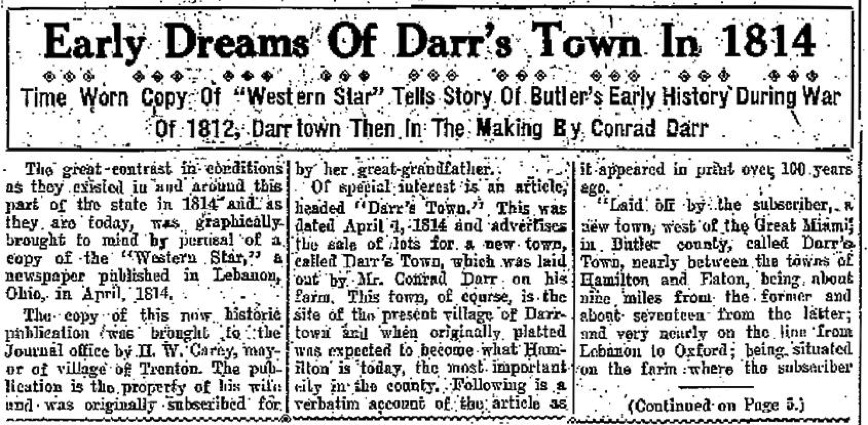
BELOW: Reproduction of 1931 news item about Darr's 1814 advertisement
ARTICLE N0.
1

ARTICLE N0.
2
1994 newspaper article cites Darr's
1814 advertisement: "Darrtown high, dry, and healthful..."

1817
The Hitching Post opens for business
The following item, which appears to be a news article, was donated to the Darrtown website. The source is unknown.

1825
U. S. Post Office opens in Darrtown
Information about the opening and closing of the Darrtown post office is available at: Darrtown Post Office.

1842-1846
Darrtown Pike constructed


Around the turn of 19th century, roads to and from Darrtown were paths through the forest.
Men literally carved roadways
out of the wilderness.
Morton Irwin made his mark on area history, when he cleared land for the route through Section 17 of Milford Township. The blue line, marked on the map at the right, approximates the route of the Darrtown Pike.
Morton Irwin settled in section 17 of Milford Township in 1800.
The following story of Morton Irwin's impact on the Darrtown Pike was taken from the obituary of John Irwin, son of Morton Irwin.
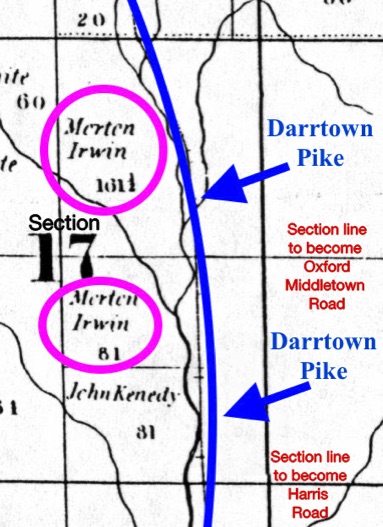
"... His father [Morton Irwin] came west in 1798, settling in the neighborhood of the Big Pond, in Fairfield Township, and two years after moving to Milford Township, which then had no highways. He settled two miles and a half north of Darrtown, afterwards cutting the road from Darrtown to his farm, being a part of the same road known as the Hamilton and Richmond Pike. His father cut the first tree ever cut by a white man on Section 17, Milford Township."
The roadway that was cleared from south of Darrtown to the north - through Jerico and Morning Sun and Fairhaven and eventually, reaching Richmond, Indiana - became known locally as the "Darrtown Pike." Officially, it is State Rt. 177 and/or the Hamilton-Richmond Road.
"Drovers" were people who "drove" (i.e. - led, guided or herded) livestock to travel/walk in a particular direction. In the case of the Darrtown Pike, drovers were heading livestock south from farms in both western Ohio and eastern Indiana...to the Cincinnati stock yards, The meat packing industry of Cincinnati was so large and well-known that the city took on the name of "Porkopolis."
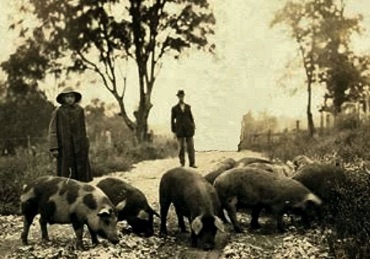
The story of Darrtown Pike serving as a livestock corridor is collaborated by the quotation below (left), which was taken from a 1973 Oxford Press news article about the Davis family, which lived at the intersection of Ohio State Routes 177 and 73.
"Alamon Davis bought the 160-acre Milford Township farm located at the northwest corner of the Hamilton-Richmond Pike and the Oxford-Trenton Road. The property, which Alamon purchased several years prior to his death in 1883, included a stone house that sat close to the crossroads. That structure, which included a building stone dated 1816, initially served as a toll house and inn for the drovers, who guided livestock south on the Darrtown Pike towards the Cincinnati slaughter and packing houses."
See related info at the Davis Family page
The trails used by drovers became pathways for other travelers and eventually many of those drover trials evolved into roads traveled yet today.
The two links, at the right, connect to a two-page article about old trails becoming today's roads. While this article (taken from an undated Automobile Association magazine that was donated by Ron Wiley) focuses on roadways in the western part of Butler County, Ohio, the content of the article applies to, and parallels the experiences of, those who guided livestock on Darrtown Pike.
Lanes Mill opens on the Four Mile Creek; southwest of Darrtown
Lane's Mill, located approximately three miles southwest of Darrtown at the intersection of Lanes Mill Road and Wallace Road, was a combination saw, grist, and fulling mill, that was constructed in 1848. It was added to the National Register of Historic Places in 1980. Unfortunately, the structure fell into disrepair and was razed in the first decade of the 21st century.
To reach the SITE where Lanes' Mill was located, travel west, from Darrtown, on Schollenbarger Road and then south on Lanes Mill Road to Wallace Road.
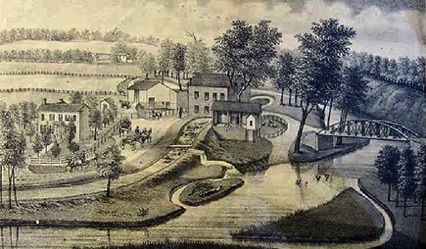
For more information about, and photographs of, this historic mill, click the following link to access the Lane's Mill page.
The April 1, 1931 edition of the Hamilton Evening Journal included a story about an advertisement that appeared in the April 1, 1814 edition of the Western Star newspaper, published in Lebanon, Ohio. The 1931 news item from the Hamilton Evening Journal included the following explanation of how the 1814 Western Star news article surfaced:
The headline of the 1931 Hamilton Evening News article read:
"Early Dreams Of Darr's Town in 1814
"Time Worn Copy of 'Western Star'
Tells Story of Butler's Early History
During War of 1812,
.Darrtown Then In Making
By Conrad Darr"
The following information was taken from an article, written by Jim Blount, that appeared in the Hamilton Journal-News, Wednesday, Aug. 3, 1994.
"Darrtown was 'high, dry and healthful,' Conrad Darr's 1814 advertisement claimed.
"The 'high, dry and healthful situation can not be exceeded by none in the state,' boasted a Butler County developer in describing his available real estate.
Conrad Darr also emphasized there were 'more than 50 never-failing springs near Darr's Town -- now Darrtown -- in his advertisements in weekly newspapers in 1814.
In 1802, Conrad Darr, Robert Ogle and William Ogle -- all from Pennsylvania -- paid $800, or $1.25 an acre, for the 640 acres in Section 28 of Milford Township. Darr and his wife, Catherine, established their family in the southern half of the section while the Ogles split the remaining 320 acres.
After farming some of the land for 10 years, Darr laid out a town, gave it his name, recorded the plat April 4, 1814, and placed ads in area newspapers. His description of the land started with this 82-word sentence:
'Laid out by the subscriber, a new town west of the Great Miami in Butler County, called Darr's Town, nearly between the towns of Hamilton and Eaton, being about nine miles from the former and about 17 miles from the latter, and very nearly on the line from Lebanon to Oxford; being situated on the farm where the subscriber has lived upwards of 10 years; and for a high, dry and healthful situation can not be exceeded by none in the state.'
The ad continued with a reference to the 'more than 50 never-failing springs' in the vicinity. 'Also within ninety poles of the town,' the ad said, 'is a seat for water works, which promises early and superior advantages to almost any in the county. Also, a grist mill, building within one mile of the town, together with a number of both grist and saw mills in complete operation, within three or four miles of said town.'
'This town being in the middle of the richest part of the Miami country and uniting so many superior advantages, together with the solicitations of a number of merchants and mechanics, have induced the subscriber to commence on Thursday, the 5th day of May next, and continue from day to day until the whole be sold or offered.'
Darr said terms of the sale would 'be made known the first morning of the sale,' and they 'will be easier to be complied with than what is common in this country.' He said 'the plan of said town can be seen either at the recorder's office or with the subscriber. All kinds of mechanics, merchants, etc., are particularly invited to attend.'
Early county histories identify Abraham (or Abram) Darr -- not Conrad Darr -- as Darrtown's first resident and first merchant, possibly before the town was platted. Later, he was a Milford Township justice of the peace.
Abraham Darr also became the town's first postmaster in 1825, operating the service from his store and tavern. The post office continued for 82 years -- from Jan. 18, 1825, until Jan. 31, 1907.
The early histories report Conrad Darr, the town's founder, donated land for a Darrtown Town Hall, which was built in 1826 or 1827. It doubled as a church. A Darrtown school was built by George Howard, and a cemetery was laid out in by Thomas Cooch and a Mr. Markle."
Currently, we have two sources of information about the construction of Darrtown Pike.
According to the following source, it appears that the construction of a Hamilton to Richmond "turnpike" began in 1838.
TURNPIKE COMPANY FORMED
An undated newspaper article, written by Mr. Jim Blount, includes the following quotation about the construction of the roadway that became locally known as the "Darrtown Pike."
Mr. Blount described how, in 1829, James McBride "was also involved in the formation of the Hamilton, Rossville, and Richmond Turnpike Company, incorporated in January 1830. He also had a hand in its construction, which began in 1838, under the Hamilton, Rossville, Darrtown, Oxford, and Fairhaven Turnpike Company."
According to the following source, it appears that the Darrtown Pike portion of the turnpike occurred between 1842-46.
The Darrtown Pike construction dates (1842 to 1846) and the background story of its construction were determined by the following excerpts taken from Mr. L. A. Miller's diaries.
• In his 1932 diary, Mr. Miller wrote "October 14: … Power machines are making road fast on this old neglected turnpike from Hamilton Ohio to Richmond Indiana; the first Pike, built by stockholders from Cincinnati to Richmond, Indiana. I paid toll on part of it, from Darrtown to Hamilton County line for several years. It was bought out by the County commissioners about 1884 or 1885." Resource found at: Miller diary - 1932
• In his 1936 diary, Mr. Miller wrote: "Sunday, May 24: At home all day. A lot of auto travel on our Cincinnati, Hamilton, Richmond Pike - constructed 1842 to 1846; [as] a toll road. Made a free pike - 1883." Resource found at: Miller diary - 1936
Presumably, the turnpike construction began in the Hamilton / Rossville area and progressed northward, toward Richmond, Indiana, via Darrtown and Fairhaven.
Notice that Mr. Miller refers to the pike as a "toll road" that became a "free pike" some 40 years later - in 1883.
For many years, the intersection of St. Rt. 177 and St. Rt. 73 was known locally as "Davis Corner." Here is some background info about that property that relates to the Darrtown Pike:
While living in Liberty Township, Alamon Davis bought the 160-acre Milford Township farm located at the northwest corner of the Hamilton-Richmond Pike and the Oxford-Trenton Road. The property, which Alamon purchased several years prior to his death in 1883, included a stone house that sat close to the crossroads. That structure, which included a building stone dated 1816, initially served as a toll house and inn for the drovers, who guided livestock south on the Darrtown Pike towards the Cincinnati slaughter and packing houses. See more at: Davis Family page.
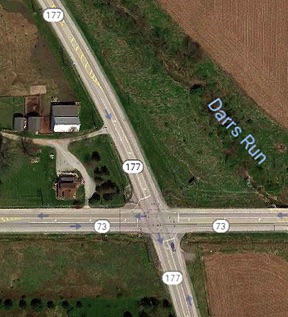
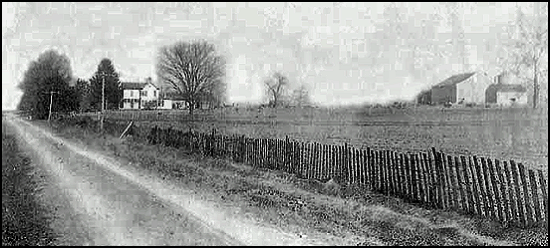
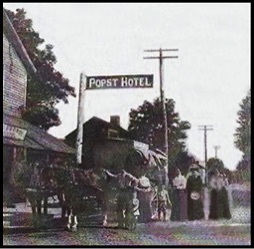
ABOVE: This undated photo shows the Darrtown Pike, when it was an unpaved roadway. The Kramer farm, located on the east side of the pike, south of Harris Road) appears in the background. For more info, see the Kramer Family page.
ABOVE: A horsedrawn stage makes a stop in Darrtown, on Main Street (Darrtown Pike). See Popst Hotel story.

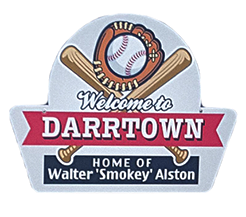
BACKGROUND:
On October 15, 2000, about 300 townspeople and baseball fans attended dedication ceremonies that unveiled a Walter “Smokey” Alston monument in the southwest quadrant of the Darrtown village square.
The organzers of the ceremony also arranged for the Darrtown section of St. Rt. 177 to be named the: "Walter 'Smokey' Alston Memorial Highway."
See the official language of the
Ohio Revised Code at the right.
See more at Darrtown sports stories
Ohio Revised Code »
Title [55] LV ROADS - HIGHWAYS - BRIDGES » Chapter 5533: MEMORIAL HIGHWAYS
5533.39 Walter Smokey Alston memorial highway.
The road known as state route number one hundred seventy-seven, within the community of Darrtown in Butler county only, shall be known as the "Walter 'Smokey' Alston Memorial Highway."
The director of transportation may erect suitable markers along the highway indicating its name.
Effective Date: 11-22-1999.
In the fall of 2018, the Darrtown Reunion Committee erected two signs (like the image above) alongside St. Rt. 177, at the north and south entrances to the village.
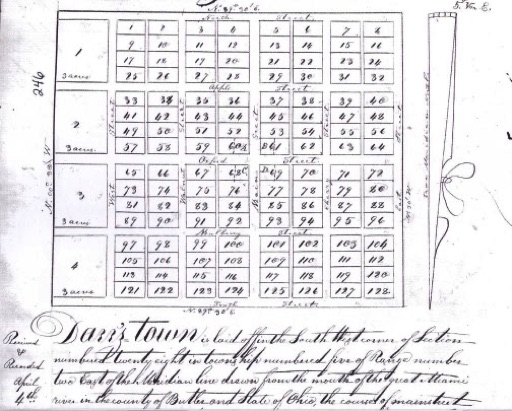
1802: Darr, Ogle, and Ogle enter Milford Township
1803; The construction of the Kyger family cabin
1814: The platting of Darrtown
1817: The opening of the Hitching Post tavern
1825: The opening of the Darrtown post office
1842-1846: The construction of "Darrtown Pike"
1848: The construction and operation of Lane's mill
1848
“In 1802, Conrad Darr, an early Butler County settler, purchased half of Section 28 from the Symmes interests for $0.25 an acre and in 1814, he laid out the village that now bears his name, Darrtown.
In Milford Township, Abram F. Darr was the first to settle here and kept a provisions store-inn for several years. Drovers walking sheep, cattle, and hogs to Cincinnati would put up here for the night and rest.
Mr. Darr opened Darrtown’s first tavern in 1817 on Lot Number 52, calling it the “Hitching Post,” because of the large, crude tying rail in front of the tavern-inn, an important stop on the Hamilton-Fairborn Stage Coach line. Here one could get a free drink or a gallon of whiskey for 50 cents in the customer’s jug-or 75 cents a gallon, if the tavern furnished the jug.
Distilling became an important industry in the vicinity. If it was a good corn year, whisky became legal tender in the area and a most popular medium of exchange. James Bradberry owned a log still house as early as 1817, which in later years, was replaced by a native stone building. Abram Darr opened his own distillery in 1832. Mitchell Marshall conducted a 15-barrel establishment from 1845 to 1852.
Members of the most respected families in the community were tavern keepers; Aaron Chamberlain, Stephen Kendall, and William Kirkpatrick kept taverns here in later years. All notices of town meetings, elections, newly passed laws and ordinances were posted both in and outside the taverns to inform citizenry, much as is done by the newspapers of today. Bills of Sale, notices of auctions, and records of transfers were also posted. Everyone in the township would flock to the tavern-inns, if they wished to known what was going on. There, too, one learned all the gossip or scandal that was bandied about the locality. These gathering places were truly the “hub of community life.”
If you have family roots to Darrtown, perhaps your great grandfather-and maybe even your great-great grandfather-hitched his horse to the rail outside the Hitching Post, Butler County’s friendly tavern, the building that is now almost a century and a half old.”
For more info on this historic establishment, see the Hitching Post.

The Darrtown section of the OHGen Web Project appears as a video on the OHGen video page.
Click the following link to see an 1838 newspaper article about building a Hamilton to Darrtown to Fairhaven...
